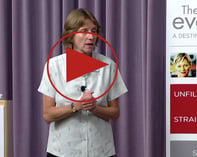Published on
VIDEO | The Higher Ed Revolution Requires Employer Participation
This trailer highlights some of the interesting ideas and innovative insights shared by all three speakers at The EvoLLLution Symposium on Higher Education and the Workforce, hosted at Stanford University. To watch the full video, please click here.
I’m a non-traditional student. I’ve been in the workforce for more than 20 years and before I transferred to UCLA — where I just completed my bachelor’s degree — I attended community college.
My first day at community college was rather nerve-wracking. Trust me, when you’re 30-something with a backpack and you find someone with a shared experience, you’re like, “Thank God! Let’s talk.” This is how I met Robert.
It turns out Robert served in the Air Force where he managed about 30 people and a budget of $2 million a year. But, even though he was so highly skilled and experienced, he couldn’t get a job. This just didn’t make sense to me. How is someone who has so much work experience not valued in the workforce? As it turns out, this situation is not unusual. Employers require degrees in even the most entry-level positions.
What non-traditional and transfer students really need is for the system itself to change, but students can’t really do that alone. After all, the problem goes much deeper than a lack of degrees; it’s more systemic. This system is built for learning for learning’s sake. It focuses on the idea that university students will end up remaining in academia and contributing to society’s pool of knowledge.
As students, we can certainly be active and demand to learn topics that relate directly to workforce-focused outcomes, but we’re not in a position where we can ask for significant changes to the curricula. We can’t teach teachers how to teach. There’s still this gap between what’s taught in the classroom versus the pragmatic skills that contribute to being successful in today’s economy.
So, what’s the answer? What’s needed to close the gap between higher education and the workforce is a one-two punch where students are pushing from one side and employers from the other.
At base level, employers should start communicating with universities. They need to talk to faculty and provosts and presidents about what they need from graduates. To take it a step further, businesses need to get involved in the program planning process. Wouldn’t it be terrific if employers would work parallel with faculty to develop programs that met teaching aims and accreditor demands while still preparing students for the labor market? This could create an applied liberal arts system, one in which students could actively participate in the learning process and that would serve them outside the classroom.
All students can benefit from work experience in their academic program. Employers would benefit too. This is one area where leaps have definitely been made. We have co-op programs existing already, but I feel like there needs to be more of an alignment between the classroom learning and workplace outcomes.
Maybe we could change the higher education system and have students spend a year of their university or high school time working, apprenticeship-style. They could have more time and opportunity to have more knowledge to apply to the job. In the case of non-traditional students, maybe the programs could focus on technical issues and business ideas that would make them competitive.
I’m certainly not blind to the challenges in the way of some of the concepts I’ve brought up, but the main problem is businesses aren’t communicating with universities and universities are hesitant to communicate with businesses. Universities aren’t really interested in innovation. It’s not for lack of wanting; it’s just because of the systemic habit.
A system overhaul is really what we need. This could be one that turns traditional higher education on its head or, at the very least, create a higher education stream for students who intend to work outside of academia. This is really almost impossible for students to do on their own.
We’re starting to see some collaboration at the institutional level between students and the university. We need business and the academic world to stop working at arm’s length from another and then and only then can students see the outcomes we need to succeed.
This presentation has been edited for length.
Heather Adams was the second of three speakers at The EvoLLLution’s Symposium on Higher Education and the Workforce, hosted by Stanford University. The Symposium featured three snapshot talks by people on very different ends of the higher education-workforce divide (an employer, a student and an administrator), sharing their perspectives on how to close the gap between these two spaces. Over the past month, we published the talks by Maggie Johnson, Director for University Relations at Google and Edward Abeyta | Director of K-16 Programs, UC San Diego.
The above trailer provides a small taste of the innovative ideas and insights shared The EvoLLLution Symposium on Higher Education and the Workforce. To watch the full event and hear all three speakers, please click here:
| WATCH FULL PRESENTATION |
Author Perspective: Student



